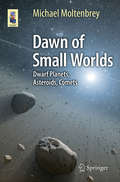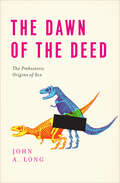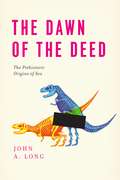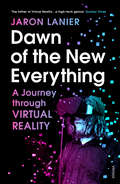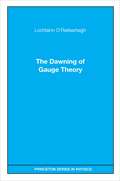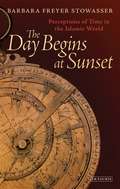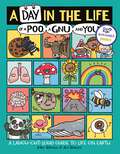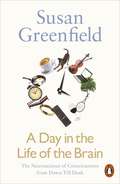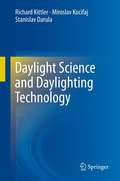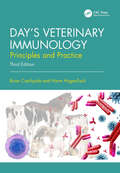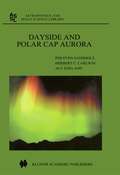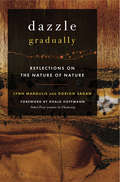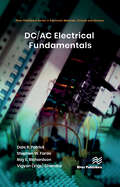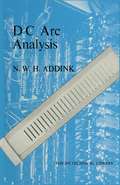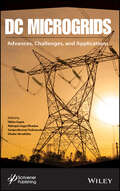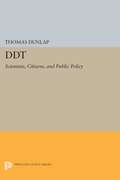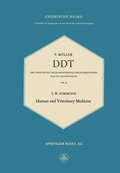- Table View
- List View
Dawn of Small Worlds: Dwarf Planets, Asteroids, Comets (Astronomers' Universe)
by Michael MoltenbreyThis book gives a detailed introduction to the thousands and thousands of smaller bodies in the solar system. Written for interested laymen, amateur astronomers and students it describes the nature and origin of asteroids, dwarf planets and comets, and gives detailed information about their role in the solar system. The author nicely reviews the history of small-world-exploration and describes past, current and future space craft missions studying small worlds, and presents their results. Readers will learn that small solar system worlds have a dramatically different nature and appearance than the planets. Even though research activity on small worlds has increased in the recent past many of their properties are still in the dark and need further research.
The Dawn of the Deed: The Prehistoric Origins of Sex
by John A. LongWe all know about the birds and the bees, but what about the ancient placoderm fishes and the dinosaurs? The history of sex is as old as life itself—and as complicated and mysterious. And despite centuries of study there is always more to know. In 2008, paleontologist John A. Long and a team of researchers revealed their discovery of a placoderm fish fossil, known as “the mother fish,” which at 380 million years old revealed the oldest vertebrate embryo—the earliest known example of internal fertilization. As Long explains, this find led to the reexamination of countless fish fossils and the discovery of previously undetected embryos. As a result, placoderms are now considered to be the first species to have had intimate sexual reproduction or sex as we know it—sort of. Inspired by this incredible find, Long began a quest to uncover the paleontological and evolutionary history of copulation and insemination. In The Dawn of the Deed, he takes readers on an entertaining and lively tour through the sex lives of ancient fish and exposes the unusual mating habits of arthropods, tortoises, and even a well-endowed (16.5 inches!) Argentine Duck. Long discusses these significant discoveries alongside what we know about reproductive biology and evolutionary theory, using the fossil record to provide a provocative account of prehistoric sex. The Dawn of the Deed also explores fascinating revelations about animal reproduction, from homosexual penguins to monogamous seahorses to the difficulties of dinosaur romance and how sexual organs in ancient shark-like fishes actually relate to our own sexual anatomy. The Dawn of the Deed is Long’s own story of what it’s like to be a part of a discovery that rewrites evolutionary history as well as an absolutely rollicking guide to sex throughout the ages in the animal kingdom. It’s natural history with a naughty wink.
The Dawn of the Deed: The Prehistoric Origins of Sex
by John A. LongWe all know about the birds and the bees, but what about the ancient placoderm fishes and the dinosaurs? The history of sex is as old as life itself—and as complicated and mysterious. And despite centuries of study there is always more to know. In 2008, paleontologist John A. Long and a team of researchers revealed their discovery of a placoderm fish fossil, known as “the mother fish,” which at 380 million years old revealed the oldest vertebrate embryo—the earliest known example of internal fertilization. As Long explains, this find led to the reexamination of countless fish fossils and the discovery of previously undetected embryos. As a result, placoderms are now considered to be the first species to have had intimate sexual reproduction or sex as we know it—sort of. Inspired by this incredible find, Long began a quest to uncover the paleontological and evolutionary history of copulation and insemination. In The Dawn of the Deed, he takes readers on an entertaining and lively tour through the sex lives of ancient fish and exposes the unusual mating habits of arthropods, tortoises, and even a well-endowed (16.5 inches!) Argentine Duck. Long discusses these significant discoveries alongside what we know about reproductive biology and evolutionary theory, using the fossil record to provide a provocative account of prehistoric sex. The Dawn of the Deed also explores fascinating revelations about animal reproduction, from homosexual penguins to monogamous seahorses to the difficulties of dinosaur romance and how sexual organs in ancient shark-like fishes actually relate to our own sexual anatomy. The Dawn of the Deed is Long’s own story of what it’s like to be a part of a discovery that rewrites evolutionary history as well as an absolutely rollicking guide to sex throughout the ages in the animal kingdom. It’s natural history with a naughty wink.
The Dawn of the Deed: The Prehistoric Origins of Sex
by John A. LongWe all know about the birds and the bees, but what about the ancient placoderm fishes and the dinosaurs? The history of sex is as old as life itself—and as complicated and mysterious. And despite centuries of study there is always more to know. In 2008, paleontologist John A. Long and a team of researchers revealed their discovery of a placoderm fish fossil, known as “the mother fish,” which at 380 million years old revealed the oldest vertebrate embryo—the earliest known example of internal fertilization. As Long explains, this find led to the reexamination of countless fish fossils and the discovery of previously undetected embryos. As a result, placoderms are now considered to be the first species to have had intimate sexual reproduction or sex as we know it—sort of. Inspired by this incredible find, Long began a quest to uncover the paleontological and evolutionary history of copulation and insemination. In The Dawn of the Deed, he takes readers on an entertaining and lively tour through the sex lives of ancient fish and exposes the unusual mating habits of arthropods, tortoises, and even a well-endowed (16.5 inches!) Argentine Duck. Long discusses these significant discoveries alongside what we know about reproductive biology and evolutionary theory, using the fossil record to provide a provocative account of prehistoric sex. The Dawn of the Deed also explores fascinating revelations about animal reproduction, from homosexual penguins to monogamous seahorses to the difficulties of dinosaur romance and how sexual organs in ancient shark-like fishes actually relate to our own sexual anatomy. The Dawn of the Deed is Long’s own story of what it’s like to be a part of a discovery that rewrites evolutionary history as well as an absolutely rollicking guide to sex throughout the ages in the animal kingdom. It’s natural history with a naughty wink.
The Dawn of the Deed: The Prehistoric Origins of Sex
by John A. LongWe all know about the birds and the bees, but what about the ancient placoderm fishes and the dinosaurs? The history of sex is as old as life itself—and as complicated and mysterious. And despite centuries of study there is always more to know. In 2008, paleontologist John A. Long and a team of researchers revealed their discovery of a placoderm fish fossil, known as “the mother fish,” which at 380 million years old revealed the oldest vertebrate embryo—the earliest known example of internal fertilization. As Long explains, this find led to the reexamination of countless fish fossils and the discovery of previously undetected embryos. As a result, placoderms are now considered to be the first species to have had intimate sexual reproduction or sex as we know it—sort of. Inspired by this incredible find, Long began a quest to uncover the paleontological and evolutionary history of copulation and insemination. In The Dawn of the Deed, he takes readers on an entertaining and lively tour through the sex lives of ancient fish and exposes the unusual mating habits of arthropods, tortoises, and even a well-endowed (16.5 inches!) Argentine Duck. Long discusses these significant discoveries alongside what we know about reproductive biology and evolutionary theory, using the fossil record to provide a provocative account of prehistoric sex. The Dawn of the Deed also explores fascinating revelations about animal reproduction, from homosexual penguins to monogamous seahorses to the difficulties of dinosaur romance and how sexual organs in ancient shark-like fishes actually relate to our own sexual anatomy. The Dawn of the Deed is Long’s own story of what it’s like to be a part of a discovery that rewrites evolutionary history as well as an absolutely rollicking guide to sex throughout the ages in the animal kingdom. It’s natural history with a naughty wink.
The Dawn of the Deed: The Prehistoric Origins of Sex
by John A. LongWe all know about the birds and the bees, but what about the ancient placoderm fishes and the dinosaurs? The history of sex is as old as life itself—and as complicated and mysterious. And despite centuries of study there is always more to know. In 2008, paleontologist John A. Long and a team of researchers revealed their discovery of a placoderm fish fossil, known as “the mother fish,” which at 380 million years old revealed the oldest vertebrate embryo—the earliest known example of internal fertilization. As Long explains, this find led to the reexamination of countless fish fossils and the discovery of previously undetected embryos. As a result, placoderms are now considered to be the first species to have had intimate sexual reproduction or sex as we know it—sort of. Inspired by this incredible find, Long began a quest to uncover the paleontological and evolutionary history of copulation and insemination. In The Dawn of the Deed, he takes readers on an entertaining and lively tour through the sex lives of ancient fish and exposes the unusual mating habits of arthropods, tortoises, and even a well-endowed (16.5 inches!) Argentine Duck. Long discusses these significant discoveries alongside what we know about reproductive biology and evolutionary theory, using the fossil record to provide a provocative account of prehistoric sex. The Dawn of the Deed also explores fascinating revelations about animal reproduction, from homosexual penguins to monogamous seahorses to the difficulties of dinosaur romance and how sexual organs in ancient shark-like fishes actually relate to our own sexual anatomy. The Dawn of the Deed is Long’s own story of what it’s like to be a part of a discovery that rewrites evolutionary history as well as an absolutely rollicking guide to sex throughout the ages in the animal kingdom. It’s natural history with a naughty wink.
The Dawn of the Deed: The Prehistoric Origins of Sex
by John A. LongWe all know about the birds and the bees, but what about the ancient placoderm fishes and the dinosaurs? The history of sex is as old as life itself—and as complicated and mysterious. And despite centuries of study there is always more to know. In 2008, paleontologist John A. Long and a team of researchers revealed their discovery of a placoderm fish fossil, known as “the mother fish,” which at 380 million years old revealed the oldest vertebrate embryo—the earliest known example of internal fertilization. As Long explains, this find led to the reexamination of countless fish fossils and the discovery of previously undetected embryos. As a result, placoderms are now considered to be the first species to have had intimate sexual reproduction or sex as we know it—sort of. Inspired by this incredible find, Long began a quest to uncover the paleontological and evolutionary history of copulation and insemination. In The Dawn of the Deed, he takes readers on an entertaining and lively tour through the sex lives of ancient fish and exposes the unusual mating habits of arthropods, tortoises, and even a well-endowed (16.5 inches!) Argentine Duck. Long discusses these significant discoveries alongside what we know about reproductive biology and evolutionary theory, using the fossil record to provide a provocative account of prehistoric sex. The Dawn of the Deed also explores fascinating revelations about animal reproduction, from homosexual penguins to monogamous seahorses to the difficulties of dinosaur romance and how sexual organs in ancient shark-like fishes actually relate to our own sexual anatomy. The Dawn of the Deed is Long’s own story of what it’s like to be a part of a discovery that rewrites evolutionary history as well as an absolutely rollicking guide to sex throughout the ages in the animal kingdom. It’s natural history with a naughty wink.
The Dawn of the Deed: The Prehistoric Origins of Sex
by John A. LongWe all know about the birds and the bees, but what about the ancient placoderm fishes and the dinosaurs? The history of sex is as old as life itself—and as complicated and mysterious. And despite centuries of study there is always more to know. In 2008, paleontologist John A. Long and a team of researchers revealed their discovery of a placoderm fish fossil, known as “the mother fish,” which at 380 million years old revealed the oldest vertebrate embryo—the earliest known example of internal fertilization. As Long explains, this find led to the reexamination of countless fish fossils and the discovery of previously undetected embryos. As a result, placoderms are now considered to be the first species to have had intimate sexual reproduction or sex as we know it—sort of. Inspired by this incredible find, Long began a quest to uncover the paleontological and evolutionary history of copulation and insemination. In The Dawn of the Deed, he takes readers on an entertaining and lively tour through the sex lives of ancient fish and exposes the unusual mating habits of arthropods, tortoises, and even a well-endowed (16.5 inches!) Argentine Duck. Long discusses these significant discoveries alongside what we know about reproductive biology and evolutionary theory, using the fossil record to provide a provocative account of prehistoric sex. The Dawn of the Deed also explores fascinating revelations about animal reproduction, from homosexual penguins to monogamous seahorses to the difficulties of dinosaur romance and how sexual organs in ancient shark-like fishes actually relate to our own sexual anatomy. The Dawn of the Deed is Long’s own story of what it’s like to be a part of a discovery that rewrites evolutionary history as well as an absolutely rollicking guide to sex throughout the ages in the animal kingdom. It’s natural history with a naughty wink.
Dawn of the New Everything: A Journey Through Virtual Reality
by Jaron LanierJaron Lanier, ‘the father of Virtual Reality … a high-tech genius’ (Sunday Times), tells the extraordinary story of how in just over three decades Virtual Reality went from being a dream to a reality – and how its power to turn dreams into realities will transform us and our world.Virtual Reality has long been one of the dominant clichés of science fiction. Now Virtual Reality is a reality: those big headsets that make people look ridiculous, even while radiating startled delight; the place where war veterans overcome PTSD, surgeries are trialled, aircraft and cities are designed. But VR is far more interesting than any single technology, however spectacular. It is, in fact, the most effective device ever invented for researching what a human being actually is – and how we think and feel.More than thirty years ago, legendary computer scientist, visionary and artist Jaron Lanier pioneered its invention. Here, in what is likely to be one of the most unusual books you ever read, he blends scientific investigation, philosophical thought experiment and his memoir of a life lived at the centre of digital innovation to explain what VR really is: the science of comprehensive illusion; the extension of the intimate magic of earliest childhood into adulthood; a hint of what life would be like without any limits. As Lanier shows, we are standing on the threshold of an entirely new realm of human creativity, expression, communication and experience. While we can use VR to test our relationship with reality, it will test us in return, for how we choose to use it will reveal who we truly are.Welcome to a mind-expanding, life-enhancing, world-changing adventure.
The Dawning of Gauge Theory (Princeton Series in Physics #106)
by Lochlainn O'RaifeartaighDuring the course of this century, gauge invariance has slowly emerged from being an incidental symmetry of electromagnetism to being a fundamental geometrical principle underlying the four known fundamental physical interactions. The development has been in two stages. In the first stage (1916-1956) the geometrical significance of gauge-invariance gradually came to be appreciated and the original abelian gauge-invariance of electromagnetism was generalized to non-abelian gauge invariance. In the second stage (1960-1975) it was found that, contrary to first appearances, the non-abelian gauge-theories provided exactly the framework that was needed to describe the nuclear interactions (both weak and strong) and thus provided a universal framework for describing all known fundamental interactions. In this work, Lochlainn O'Raifeartaigh describes the former phase. O'Raifeartaigh first illustrates how gravitational theory and quantum mechanics played crucial roles in the reassessment of gauge theory as a geometric principle and as a framework for describing both electromagnetism and gravitation. He then describes how the abelian electromagnetic gauge-theory was generalized to its present non-abelian form. The development is illustrated by including a selection of relevant articles, many of them appearing here for the first time in English, notably by Weyl, Schrodinger, Klein, and London in the pre-war years, and by Pauli, Shaw, Yang-Mills, and Utiyama after the war. The articles illustrate that the reassessment of gauge-theory, due in a large measure to Weyl, constituted a major philosophical as well as technical advance.
The Day Begins at Sunset: Perceptions of Time in the Islamic World (Library of Middle East History)
by Barbara Freyer StowasserThe vision of Time in the Qur'an is that of a divine gift created for the benefit of humankind. Night and day, and the twelve lunar months of the year, are 'appointed times for the believing people'. Reading the sky for the prayers of the hour has thus for Muslims been a constant reminder of God's providence and power. In her absorbing and illuminating new book, the late Barbara Freyer Stowasser examines the various ways in which Islam has structured, ordered and measured Time. Drawing on examples from Judaism and Christianity, as well as the ancient world, the author shows that while systems of time facilitate the orderly function of vastly different civilizations, in Islam they have always been fundamental. Among other topics, she discusses the Muslim lunar calendar; the rise of the science of astronomy; the remarkable career of al-Biruni, greatest authority in Muslim perceptions of Time; and the impact of technologies like the astrolabe, Indian numerals and paper. The fullest account of the fascinating nexus between Islam and Time ever written, this is a major contribution to the wider history of ideas and religion.
A Day in the Life of a Poo, a Gnu and You (Winner of the Blue Peter Book Award 2021)
by Mike BarfieldWINNER OF THE BLUE PETER BOOK AWARD 2021___________If you've ever wanted to know what a panda does all day long, how your heart manages to shift all that blood around your body or what makes a rainbow shine, you've come to the right book. A Day in the Life of a Poo, a Gnu and You features the answers to all of these questions and many more, all told in a super-fun comic book format in three awesome sections: Human Body, Animal Kingdom and Earth and Science. A Day in the Life... is packed with facts, laughs and amazing illustrations you can dive into all day long. Meet your grumpy liver that has to do practically EVERYTHING; your trusty hands that are very, well, handy; the spiky porcupines ready to charge; lonely Mars rovers abandoned on the Red Planet; raging tornadoes ready to rip through the pages of the book and bubbly volcanoes ready to blow. All entries are told in the fun, friendly and informative style of Mike Barfield, and are brought to life by the colour-explosion of Jess Bradley's awesome illustrations.
A Day in the Life of the Brain: The Neuroscience of Consciousness from Dawn Till Dusk
by Susan GreenfieldEach of us has a unique, subjective inner world, one that we can never share directly with anyone else. But how do our physical brains actually give rise to this rich and varied experience of consciousness? In this ground-breaking book, internationally acclaimed neuroscientist Susan Greenfield brings together a series of astonishing new, empirically based insights into consciousness as she traces a single day in the life of your brain. From waking to walking the dog, working to dreaming, Greenfield explores how our daily experiences are translated into a tangle of cells, molecules and chemical blips, thereby probing the enduring mystery of how our brains create our individual selves.
Daylight Science and Daylighting Technology
by Richard Kittler Miroslav Kocifaj Stanislav DarulaSunlight profoundly influences the Earth's atmosphere and biosphere. Nature fuels the evolution of all living things, their visual systems, and the manner in which they adapt, accommodate, and habituate.Sun luminance measurements serve as data to calculate typical changes in the daily, monthly, and annual variability characteristics of daylight. Climate-based sky luminance patterns are used as models in predicting daylighting calculation and computer programs applied in architecture and building design. Historically, daylight science and daylighting technology has prioritized photometric methods of measurements, calculation, and graphical tools aimed at predicting or evaluating the daylighting of architectural design alternatives.However, due to a heightened awareness of general health and well-being, sunlight exposure and freedom from visual discomfort while undertaking visual tasks are now equally prioritized. Therefore, in order to assure optimal environmental quality, daylighting technology must be based on sound science.Daylight Science and Daylighting Technology, by Richard Kittler, Miroslav Kocifaj, and Stanislav Darula, sketches the entire evolution of daylight science from atmospheric science through apt visual workplace psychophysics.
Day's Veterinary Immunology: Principles and Practice
by Brian Catchpole Harm HogenEschMichael Day's Veterinary Immunology: Principles and Practice is the adopted text in numerous veterinary schools throughout the world. Updated and revised by Brian Catchpole and Harm HogenEsch with advances in knowledge since 2014, this third edition reflects the rapid developments in the field internationally, while preserving the strengths of Day's original writing. It adds numerous case studies demonstrating the clinical context across companion and farm animals. The textbook presents information on commonly used diagnostic test procedures and includes learning objectives at the start and key points at the end of each chapter, standard symbols in diagrams throughout the text to provide continuity, clinical examples and clinicopathological figures throughout, and a glossary of terms and list of commonly used abbreviations. Short animations are viewable via the Support Materials tab on the Routledge webpage, adding a new element of practical application. Exploring the immunological principles of both large and small animals, the book emphasizes immunological principles while applying them to disease processes and to clinical practice. It provides a practical textbook for veterinary students and a handy reference for practitioners.
Day's Veterinary Immunology: Principles and Practice
by Brian Catchpole Harm HogenEschMichael Day's Veterinary Immunology: Principles and Practice is the adopted text in numerous veterinary schools throughout the world. Updated and revised by Brian Catchpole and Harm HogenEsch with advances in knowledge since 2014, this third edition reflects the rapid developments in the field internationally, while preserving the strengths of Day's original writing. It adds numerous case studies demonstrating the clinical context across companion and farm animals. The textbook presents information on commonly used diagnostic test procedures and includes learning objectives at the start and key points at the end of each chapter, standard symbols in diagrams throughout the text to provide continuity, clinical examples and clinicopathological figures throughout, and a glossary of terms and list of commonly used abbreviations. Short animations are viewable via the Support Materials tab on the Routledge webpage, adding a new element of practical application. Exploring the immunological principles of both large and small animals, the book emphasizes immunological principles while applying them to disease processes and to clinical practice. It provides a practical textbook for veterinary students and a handy reference for practitioners.
Dayside and Polar Cap Aurora (Astrophysics and Space Science Library #270)
by Per Even Sandholt H.C. Carlson A. EgelandThe auroral emissions in the upper atmosphere of the polar regions of the Earth are evidence of the capture of energetic particles from the Sun, streaming by the Earth as the solar wind. These auroral emissions, then, are a window to outer space, and can provide us with valuable information about electrodynamic coupling processes between the solar wind and the Earth's ionosphere and upper atmosphere. Studying the physics of these phenomena extends our understanding of our plasma universe. Ground-based remote-sensing techniques, able to monitor continuously the variations in the signatures of aurorae, in combination with in-situ satellite and rocket measurements, promise to advance dramatically our understanding of the physical processes taking place at the interface of the atmospheres of the Earth and the Sun. Decoding their complexity brings us closer to reliable prediction of communication environments, especially at high latitudes. This understanding, in turn, will help us resolve problems of communication and navigation across polar regions.
Dazzle Gradually: Reflections on the Nature of Nature (Sciencewriters)
by Lynn Margulis Dorion Sagan Roald HoffmanAt the crossroads of philosophy and science, the sometimes-dry topics of evolution and ecology come alive in this new collection of essays--many never before anthologized. Learn how technology may be a sort of second nature, how the systemic human fungus Candida albicans can lead to cravings for carrot cake and beer, how the presence of life may be why there's water on Earth, and many other fascinating facts. The essay "Metametazoa" presents perspectives on biology in a philosophical context, demonstrating how the intellectual librarian, pornographer, and political agitator Georges Bataille was influenced by Russian mineralogist Vladimir Vernadsky and how this led to his notion of the absence of meaning in the face of the sun--which later influenced Jacques Derrida, thereby establishing a causal chain of influence from the hard sciences to topics as abstract as deconstruction and post-modernism. In "Spirochetes Awake" the bizarre connection between syphilis and genius in the life of Friedrich Nietzsche is traced. The astonishing similarities of the Acquired-Immune-Deficiency-Syndrome symptoms with those of chronic spirochete infection, it is argued, contrast sharply with the lack of evidence that "HIV is the cause of AIDS". Throughout these readings we are dazzled by the intimacy and necessity of relationships between us and our other planetmates. In our ignorance as "civilized" people we dismiss, disdain, and deny our kinship with the only productive life forms that sustain this living planet.
DC/AC Electrical Fundamentals
by Dale R. Patrick Stephen W. Fardo Ray Richardson Vigyan (Vigs) ChandraThis book explores many essential topics in a basic and easy-to-understand manner. This book, and the accompanying Electronic Devices and Circuit Fundamentals, have been modified with significant updates in content. The books are developed using a classic textbook – Electricity and Electronics: A Survey (5th Edition) – as a framework. Both new books have been structured using a similar sequence and organization as previous editions. The previous edition of Electricity and Electronics: A Survey contained 18 chapters, 8 in the Electricity section and 10 in the Electronics section.This book has been expanded to include 19 chapters, further simplifying content, and providing a more comprehensive coverage of the content. The content has been continually updated and revised through new editions and by reviewers over the years. Additional quality checks to ensure technical accuracy, clarity and coverage of content have always been an area of focus.Each edition of the text has been improved through the following features: Improved and updated text content Improved usage of illustrations and photos Use of color to add emphasis and clarify content.
DC/AC Electrical Fundamentals
by Dale R. Patrick Stephen W. Fardo Ray Richardson Vigyan (Vigs) ChandraThis book explores many essential topics in a basic and easy-to-understand manner. This book, and the accompanying Electronic Devices and Circuit Fundamentals, have been modified with significant updates in content. The books are developed using a classic textbook – Electricity and Electronics: A Survey (5th Edition) – as a framework. Both new books have been structured using a similar sequence and organization as previous editions. The previous edition of Electricity and Electronics: A Survey contained 18 chapters, 8 in the Electricity section and 10 in the Electronics section.This book has been expanded to include 19 chapters, further simplifying content, and providing a more comprehensive coverage of the content. The content has been continually updated and revised through new editions and by reviewers over the years. Additional quality checks to ensure technical accuracy, clarity and coverage of content have always been an area of focus.Each edition of the text has been improved through the following features: Improved and updated text content Improved usage of illustrations and photos Use of color to add emphasis and clarify content.
DC Microgrids: Advances, Challenges, and Applications
by Nikita Gupta Mahajan Sagar Bhaskar Sanjeevikumar Padmanaban Dhafer AlmakhlesThe electric grid is on the threshold of a paradigm shift. In the past few years, the picture of the grid has changed dramatically due to the introduction of renewable energy sources, advancements in power electronics, digitalization, and other factors. All these megatrends are pointing toward a new electrical system based on Direct Current (DC). DC power systems have inherent advantages of no harmonics, no reactive power, high efficiency, over the conventional AC power systems. Hence, DC power systems have become an emerging and promising alternative in various emerging applications, which include distributed energy sources like wind, solar and Energy Storage System (ESS); distribution networks; smart buildings, remote telecom systems; and transport electrification like electric vehicles (EVs) and shipboard. All these applications are designed at different voltages to meet their specific requirements individually because of the lack of standardization. Thus, the factors influencing the DC voltages and system operation needed to be surveyed and analyzed, which include voltage standards, architecture for existing and emerging applications, topologies and control strategies of power electronic interfaces, fault diagnosis and design of the protection system, optimal economical operation, and system reliability. This groundbreaking new volume presents these topics and trends of DC microgrids, bridging the research gap on DC microgrid architectures, control and protection challenges to enable wide-scale implementation of energy-efficient DC microgrids. Whether for the veteran engineer or the student, this is a must-have for any library.
DC Microgrids: Advances, Challenges, and Applications
by Nikita Gupta Mahajan Sagar Bhaskar Sanjeevikumar Padmanaban Dhafer AlmakhlesThe electric grid is on the threshold of a paradigm shift. In the past few years, the picture of the grid has changed dramatically due to the introduction of renewable energy sources, advancements in power electronics, digitalization, and other factors. All these megatrends are pointing toward a new electrical system based on Direct Current (DC). DC power systems have inherent advantages of no harmonics, no reactive power, high efficiency, over the conventional AC power systems. Hence, DC power systems have become an emerging and promising alternative in various emerging applications, which include distributed energy sources like wind, solar and Energy Storage System (ESS); distribution networks; smart buildings, remote telecom systems; and transport electrification like electric vehicles (EVs) and shipboard. All these applications are designed at different voltages to meet their specific requirements individually because of the lack of standardization. Thus, the factors influencing the DC voltages and system operation needed to be surveyed and analyzed, which include voltage standards, architecture for existing and emerging applications, topologies and control strategies of power electronic interfaces, fault diagnosis and design of the protection system, optimal economical operation, and system reliability. This groundbreaking new volume presents these topics and trends of DC microgrids, bridging the research gap on DC microgrid architectures, control and protection challenges to enable wide-scale implementation of energy-efficient DC microgrids. Whether for the veteran engineer or the student, this is a must-have for any library.
DDT: Scientists, Citizens, and Public Policy (PDF)
by Thomas DunlapFrom the time the public learned of DDT's dramatic containment of a typhus epidemic in Naples during World War II to the ban on DDT by the Environmental Protection Agency in 1972, this is the story of the controversial pesticide and its part in the rise of the environmental movement.Originally published in 1981.The Princeton Legacy Library uses the latest print-on-demand technology to again make available previously out-of-print books from the distinguished backlist of Princeton University Press. These editions preserve the original texts of these important books while presenting them in durable paperback and hardcover editions. The goal of the Princeton Legacy Library is to vastly increase access to the rich scholarly heritage found in the thousands of books published by Princeton University Press since its founding in 1905.
